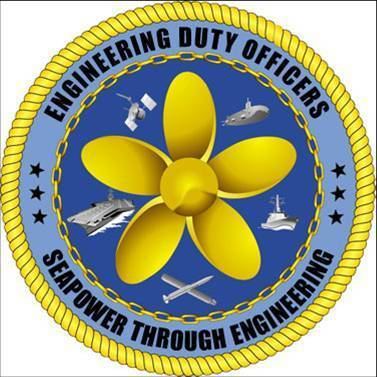 | ||
An engineering duty officer is a restricted line officer in the United States Navy, involved with the design, acquisition, construction, repair, maintenance, conversion, overhaul, or disposal of ships, submarines, aircraft carriers, and the systems on those platforms (weapons, command and control, communications, computers, etc.). As of November 30, 2011, there are approximately 791 engineering duty officers on active duty in the United States Navy, representing approximately 1.5 percent of its active-duty commissioned officers.
Contents
Mission
The Engineering Duty Officer Community Leadership [2] has stated that the purpose of the engineering duty officer community is "to provide experienced Naval Engineers known for bringing effective technical and business solutions in support of Naval Power 21 [3]; respected for integrity, adaptability, and agility. Engineering duty officers ensure that our naval and joint forces operate and fight with the most capable platforms possible. We are involved with the design, acquisition, construction, repair, maintenance, conversion, overhaul, and disposal of ships, submarines, aircraft carriers and the systems on those platforms (weapons, command and control, communications, computers, etc.). Engineering duty officers are unique to the Navy because we all start our career as URL officers. First, we learn how to operate ships or submarines. Next, all EDs obtain technical/engineering Master's degrees. Then, we combine that operational experience and technical knowledge to become the technical business leaders for the Navy."[4]
Insignia
As line officers of the Navy, engineering duty officers wear an inverted gold star above their rank stripes on both their dress blue uniforms and on their shoulder boards. In virtually all respects, their uniforms are indistinguishable from their URL counterparts. The two predominant sources of new engineering duty officers are by Lateral Transfer from another designator or by choosing to exercise an Engineering Duty Option granted upon commissioning.[5] A requirement for Lateral Transfer, or for exercising an Engineering Duty Option, is the completion of either Submarine Warfare or surface warfare qualification. Therefore, the vast majority of Engineering Duty Officers wear either the same Submarine Warfare or Surface Warfare insignia as their URL counterparts.
A small number of engineering duty officers not previously qualified as submarine warfare officers volunteer for the Engineering Duty Dolphin Program, and by successfully completing it, earn their Submarine Engineering Duty insignia. The submarine engineering duty insignia is the only United States Navy insignia which is unique to Engineering Duty Officers.
Areas of specialization
Current engineering duty officers serve in one of several career fields, including:
History
The importance of engineering duty officers in United States Navy history is memorialized in a bronze bas-relief by American sculptor Antonio Tobias "Toby" Mendez [6], on the sculpture wall at the United States Navy Memorial in Washington DC, entitled "Engineering Duty Officers – 'Sharpening the Point of the Spear.' "[7] This is one of 26 such reliefs along southern hemisphere of the Granite Sea at the Navy Memorial, which commemorate events, personnel, and communities of the various sea services.
